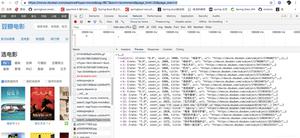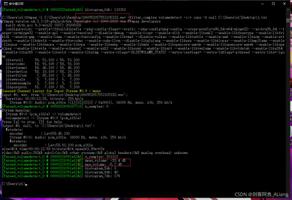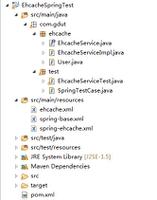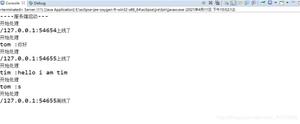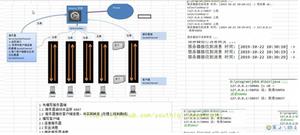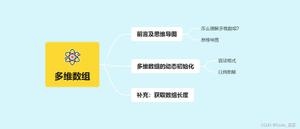转:Java NIO(2)

java.nio包是Java在1.4之后增加的,用来提高I/O操作的效率。在nio包中主要包括以下几个类或接口:
* Buffer:缓冲区,用来临时存放输入或输出数据。
* Charset:用来把Unicode字符编码和其它字符编码互转。
* Channel:数据传输通道,用来把Buffer中的数据写入到数据源,或者把数据源中的数据读入到Buffer。
* Selector:用来支持异步I/O操作,也叫非阻塞I/O操作。
nio包中主要通过下面两个方面来提高I/O操作效率:
* 通过Buffer和Channel来提高I/O操作的速度。
* 通过Selector来支持非阻塞I/O操作。
下面来看一下程序中是怎么通过这些类库实现Socket功能。
首先介绍一下几个辅助类
辅助类SerializableUtil,这个类用来把java对象序列化成字节数组,或者把字节数组反序列化成java对象。
[java] view plain copy
- package com.googlecode.garbagecan.test.socket;
- import java.io.ByteArrayInputStream;
- import java.io.ByteArrayOutputStream;
- import java.io.IOException;
- import java.io.ObjectInputStream;
- import java.io.ObjectOutputStream;
- public class SerializableUtil {
- public static byte[] toBytes(Object object) {
- ByteArrayOutputStream baos = new ByteArrayOutputStream();
- ObjectOutputStream oos = null;
- try {
- oos = new ObjectOutputStream(baos);
- oos.writeObject(object);
- byte[] bytes = baos.toByteArray();
- return bytes;
- } catch(IOException ex) {
- throw new RuntimeException(ex.getMessage(), ex);
- } finally {
- try {
- oos.close();
- } catch (Exception e) {}
- }
- }
- public static Object toObject(byte[] bytes) {
- ByteArrayInputStream bais = new ByteArrayInputStream(bytes);
- ObjectInputStream ois = null;
- try {
- ois = new ObjectInputStream(bais);
- Object object = ois.readObject();
- return object;
- } catch(IOException ex) {
- throw new RuntimeException(ex.getMessage(), ex);
- } catch(ClassNotFoundException ex) {
- throw new RuntimeException(ex.getMessage(), ex);
- } finally {
- try {
- ois.close();
- } catch (Exception e) {}
- }
- }
- }
辅助类MyRequestObject和MyResponseObject,这两个类是普通的java对象,实现了Serializable接口。MyRequestObject类是Client发出的请求,MyResponseObject是Server端作出的响应。
[java] view plain copy
- package com.googlecode.garbagecan.test.socket.nio;
- import java.io.Serializable;
- public class MyRequestObject implements Serializable {
- private static final long serialVersionUID = 1L;
- private String name;
- private String value;
- private byte[] bytes;
- public MyRequestObject(String name, String value) {
- this.name = name;
- this.value = value;
- this.bytes = new byte[1024];
- }
- public String getName() {
- return name;
- }
- public void setName(String name) {
- this.name = name;
- }
- public String getValue() {
- return value;
- }
- public void setValue(String value) {
- this.value = value;
- }
- @Override
- public String toString() {
- StringBuffer sb = new StringBuffer();
- sb.append("Request [name: " + name + ", value: " + value + ", bytes: " + bytes.length+ "]");
- return sb.toString();
- }
- }
- package com.googlecode.garbagecan.test.socket.nio;
- import java.io.Serializable;
- public class MyResponseObject implements Serializable {
- private static final long serialVersionUID = 1L;
- private String name;
- private String value;
- private byte[] bytes;
- public MyResponseObject(String name, String value) {
- this.name = name;
- this.value = value;
- this.bytes = new byte[1024];
- }
- public String getName() {
- return name;
- }
- public void setName(String name) {
- this.name = name;
- }
- public String getValue() {
- return value;
- }
- public void setValue(String value) {
- this.value = value;
- }
- @Override
- public String toString() {
- StringBuffer sb = new StringBuffer();
- sb.append("Response [name: " + name + ", value: " + value + ", bytes: " + bytes.length+ "]");
- return sb.toString();
- }
- }
下面主要看一下Server端的代码,其中有一些英文注释对理解代码很有帮助,注释主要是来源jdk的文档和例子,这里就没有再翻译
[java] view plain copy
- package com.googlecode.garbagecan.test.socket.nio;
- import java.io.ByteArrayOutputStream;
- import java.io.IOException;
- import java.net.InetSocketAddress;
- import java.nio.ByteBuffer;
- import java.nio.channels.ClosedChannelException;
- import java.nio.channels.SelectionKey;
- import java.nio.channels.Selector;
- import java.nio.channels.ServerSocketChannel;
- import java.nio.channels.SocketChannel;
- import java.util.Iterator;
- import java.util.logging.Level;
- import java.util.logging.Logger;
- import com.googlecode.garbagecan.test.socket.SerializableUtil;
- public class MyServer3 {
- private final static Logger logger = Logger.getLogger(MyServer3.class.getName());
- public static void main(String[] args) {
- Selector selector = null;
- ServerSocketChannel serverSocketChannel = null;
- try {
- // Selector for incoming time requests
- selector = Selector.open();
- // Create a new server socket and set to non blocking mode
- serverSocketChannel = ServerSocketChannel.open();
- serverSocketChannel.configureBlocking(false);
- // Bind the server socket to the local host and port
- serverSocketChannel.socket().setReuseAddress(true);
- serverSocketChannel.socket().bind(new InetSocketAddress(10000));
- // Register accepts on the server socket with the selector. This
- // step tells the selector that the socket wants to be put on the
- // ready list when accept operations occur, so allowing multiplexed
- // non-blocking I/O to take place.
- serverSocketChannel.register(selector, SelectionKey.OP_ACCEPT);
- // Here's where everything happens. The select method will
- // return when any operations registered above have occurred, the
- // thread has been interrupted, etc.
- while (selector.select() > 0) {
- // Someone is ready for I/O, get the ready keys
- Iterator<SelectionKey> it = selector.selectedKeys().iterator();
- // Walk through the ready keys collection and process date requests.
- while (it.hasNext()) {
- SelectionKey readyKey = it.next();
- it.remove();
- // The key indexes into the selector so you
- // can retrieve the socket that's ready for I/O
- execute((ServerSocketChannel) readyKey.channel());
- }
- }
- } catch (ClosedChannelException ex) {
- logger.log(Level.SEVERE, null, ex);
- } catch (IOException ex) {
- logger.log(Level.SEVERE, null, ex);
- } finally {
- try {
- selector.close();
- } catch(Exception ex) {}
- try {
- serverSocketChannel.close();
- } catch(Exception ex) {}
- }
- }
- private static void execute(ServerSocketChannel serverSocketChannel) throws IOException {
- SocketChannel socketChannel = null;
- try {
- socketChannel = serverSocketChannel.accept();
- MyRequestObject myRequestObject = receiveData(socketChannel);
- logger.log(Level.INFO, myRequestObject.toString());
- MyResponseObject myResponseObject = new MyResponseObject(
- "response for " + myRequestObject.getName(),
- "response for " + myRequestObject.getValue());
- sendData(socketChannel, myResponseObject);
- logger.log(Level.INFO, myResponseObject.toString());
- } finally {
- try {
- socketChannel.close();
- } catch(Exception ex) {}
- }
- }
- private static MyRequestObject receiveData(SocketChannel socketChannel) throws IOException {
- MyRequestObject myRequestObject = null;
- ByteArrayOutputStream baos = new ByteArrayOutputStream();
- ByteBuffer buffer = ByteBuffer.allocate(1024);
- try {
- byte[] bytes;
- int size = 0;
- while ((size = socketChannel.read(buffer)) >= 0) {
- buffer.flip();
- bytes = new byte[size];
- buffer.get(bytes);
- baos.write(bytes);
- buffer.clear();
- }
- bytes = baos.toByteArray();
- Object obj = SerializableUtil.toObject(bytes);
- myRequestObject = (MyRequestObject)obj;
- } finally {
- try {
- baos.close();
- } catch(Exception ex) {}
- }
- return myRequestObject;
- }
- private static void sendData(SocketChannel socketChannel, MyResponseObject myResponseObject) throws IOException {
- byte[] bytes = SerializableUtil.toBytes(myResponseObject);
- ByteBuffer buffer = ByteBuffer.wrap(bytes);
- socketChannel.write(buffer);
- }
- }
下面是Client的代码,代码比较简单就是启动了100个线程来访问Server
[java] view plain copy
- package com.googlecode.garbagecan.test.socket.nio;
- import java.io.ByteArrayOutputStream;
- import java.io.IOException;
- import java.net.InetSocketAddress;
- import java.net.SocketAddress;
- import java.nio.ByteBuffer;
- import java.nio.channels.SocketChannel;
- import java.util.logging.Level;
- import java.util.logging.Logger;
- import com.googlecode.garbagecan.test.socket.SerializableUtil;
- public class MyClient3 {
- private final static Logger logger = Logger.getLogger(MyClient3.class.getName());
- public static void main(String[] args) throws Exception {
- for (int i = 0; i < 100; i++) {
- final int idx = i;
- new Thread(new MyRunnable(idx)).start();
- }
- }
- private static final class MyRunnable implements Runnable {
- private final int idx;
- private MyRunnable(int idx) {
- this.idx = idx;
- }
- public void run() {
- SocketChannel socketChannel = null;
- try {
- socketChannel = SocketChannel.open();
- SocketAddress socketAddress = new InetSocketAddress("localhost", 10000);
- socketChannel.connect(socketAddress);
- MyRequestObject myRequestObject = new MyRequestObject("request_" + idx, "request_" + idx);
- logger.log(Level.INFO, myRequestObject.toString());
- sendData(socketChannel, myRequestObject);
- MyResponseObject myResponseObject = receiveData(socketChannel);
- logger.log(Level.INFO, myResponseObject.toString());
- } catch (Exception ex) {
- logger.log(Level.SEVERE, null, ex);
- } finally {
- try {
- socketChannel.close();
- } catch(Exception ex) {}
- }
- }
- private void sendData(SocketChannel socketChannel, MyRequestObject myRequestObject) throws IOException {
- byte[] bytes = SerializableUtil.toBytes(myRequestObject);
- ByteBuffer buffer = ByteBuffer.wrap(bytes);
- socketChannel.write(buffer);
- socketChannel.socket().shutdownOutput();
- }
- private MyResponseObject receiveData(SocketChannel socketChannel) throws IOException {
- MyResponseObject myResponseObject = null;
- ByteArrayOutputStream baos = new ByteArrayOutputStream();
- try {
- ByteBuffer buffer = ByteBuffer.allocateDirect(1024);
- byte[] bytes;
- int count = 0;
- while ((count = socketChannel.read(buffer)) >= 0) {
- buffer.flip();
- bytes = new byte[count];
- buffer.get(bytes);
- baos.write(bytes);
- buffer.clear();
- }
- bytes = baos.toByteArray();
- Object obj = SerializableUtil.toObject(bytes);
- myResponseObject = (MyResponseObject) obj;
- socketChannel.socket().shutdownInput();
- } finally {
- try {
- baos.close();
- } catch(Exception ex) {}
- }
- return myResponseObject;
- }
- }
- }
最后测试上面的代码,首先运行Server类,然后运行Client类,就可以分别在Server端和Client端控制台看到发送或接收到的MyRequestObject或MyResponseObject对象了。
以上是 转:Java NIO(2) 的全部内容, 来源链接: utcz.com/z/394826.html

